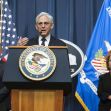Jason Joey Berry and Xuan Cahn Nguyen were extradited from Canada to stand first trial and arraignment in North Dakota in early January 2021. The two are alleged to be part of an international fentanyl trafficking organization responsible for moving more than 500 grams of Schedule I and Schedule II controlled substances containing fentanyl into the United States, through Canada, but mostly originating from China.
Berry and Nguyen were extradited to North Dakota after the filing of a superseding indictment that alleges the two conspired to import and “to distribute a controlled substance and controlled substance analogues resulting in serious bodily injury and death.” In addition to the conspiracy to distribute the drugs, Nguyen is charged with conspiracy to launder money. The two arrived in the United States on January 6 and stood preliminary trial and arraignment on January 7, 2021.
The investigation into international fentanyl trafficking began in North Dakota on January 3, 2015, when a teenager, Bailey Henke, in Grand Folks died of a fentanyl overdose. Before the teen's death, the United States had had little success finding the source of the synthetic drug entering into the country. With Operational Denial, a program funded by the Organized Crime and Drug Enforcement Task Force, authorities were able to pinpoint China as a major exporter of the drug. The State Department released a report in 2019 which found China had anywhere between 160,000 to 400,000 companies that were either legally or illegally producing chemicals for pharmaceutical companies. This vast amount of production was even more troubling when the investigation uncovered that the Chinese agency in charge of regulating was severely understaffed and underfunded.
Jason Joey Berry, also known as Daniel Desnoyers has a history of drug trafficking offenses both in the United States and Canada. Originally from Montreal, Quebec, Canada, he was arrested on October 18, 2019, by Canadian authorities at the request of the United States after investigations revealed his high-level involvement with fentanyl coming to the United States for commercial, non-medical use. Previously, in April 2013, he was arrested at a UPS store in Montreal for trying to ship to Colorado a microwave and toaster oven containing over 10,000 pills of desmethyl fentanyl and enough raw material to make thousands of more pills. Further raids into storage units associated with Berry uncovered “hundreds of thousands of synthetic prescription pills.”
While in prison, Berry enlisted the help of Daniel Vivas Ceron, who was already in prison serving a long sentence for drug trafficking into the United States from Panama. The two worked together to continue selling controlled substances over the internet to customers in the United States. The two “were the organizers and leaders in this criminal conspiracy in Canada and did so while incarcerated in the Drummond Institution in Quebec, Canada.”
The court case Pinkerton v United States (1946) cemented the legal authority of the United States to prosecute and deem guilty by association. The case states, “The actions of any member of a conspiracy can be attributed to any of the other members as long as the conspiracy lasts, even if there is no specific agreement regarding the act.” While the investigation may have dealt solely with just one individual in the entire conspiracy, all those that are connected with the group are therefore indicted.
Fentanyl was first synthesized in 1960 by a Belgian doctor, Paul Janssen. Janssen developed the drug in his family's pharmaceutical lab, which was later acquired by Johnson & Johnson in 1962. The drug was invented as a pain reliever that, at the time, proved to be the most powerful and the quickest to begin working. Fentanyl is 50 to 100 times more potent than morphine.
While the drug hit the European market almost immediately, it took more time to gain popularity in the United States. In the late 1960s, American researchers found that fentanyl as an anesthetic in open-heart surgery led to fewer side effects. After this finding, it became the anesthesia in almost every open-heart surgery in the United States. The initial way to produce fentanyl was a complicated process. However, other scientists soon found a much faster and easier way to produce the drug, leading to the first outbreak in the United States in the mid-2000s.
Data from the U.S. Centers for Disease Control and Prevention “suggests that illicitly manufactured fentanyl (IMF), as opposed to pharmaceutical fentanyl, is the main driver of the recent increase in deaths involving synthetic opioids.” Fentanyl is just one drug in the opioid crisis plaguing the United States. Between 2010 and 2015, overdose deaths due to opioids increased by almost 57%. The prescription rate for fentanyl has decreased over the past five years as lawmakers work to make it more difficult for excessive or unnecessary prescriptions, yet overdose deaths have continued to rise.






